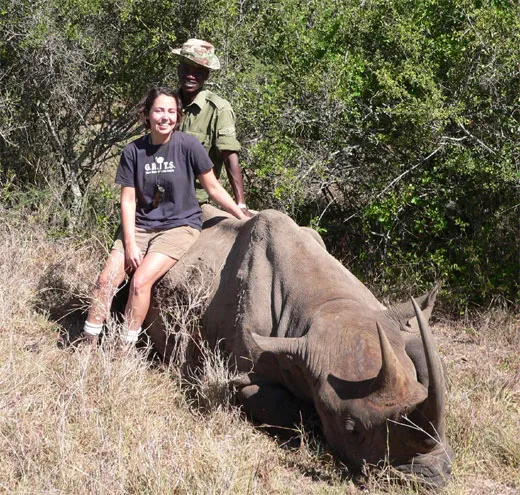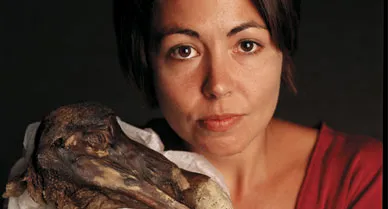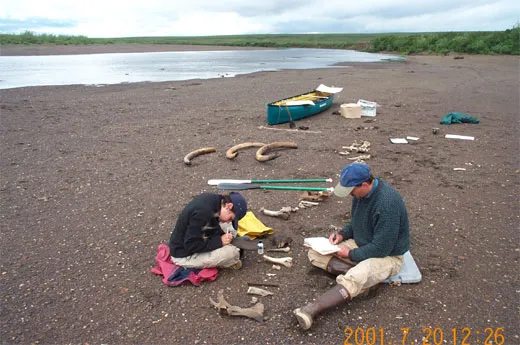How to Make a Dodo
Biologist Beth Shapiro has figured out a recipe for success in the field of ancient DNA research
Editor’s Note, September 22, 2009: Beth Shapiro is one of twenty-four individuals selected as a 2009 MacArthur Fellow by the John D. and Catherine T. MacArthur Foundation. She will receive a “genius grant” of $500,000.
If you're trying to isolate dodo DNA, follow these steps: first, find a dodo bone that hasn't fossilized. This should be easy. Among the few known in the world are a skull and a left foot that are stored in boxes on the second floor of the Oxford University Museum of Natural History. They've been in the university's possession since 1683, around the time the last dodo died. It's not a big museum, but if you get lost, look for a small plaque next to the entrance to the storeroom, where a legendary debate over Charles Darwin's theory of evolution took place in 1860.
The hard part, as biologist Beth Shapiro discovered in 2000, will be convincing collections manager Malgosia Nowak-Kemp to let you take a drill to the ultimate nonrenewable resource. True, you won't need to destroy much—a fragment the size of a pinkie fingernail should suffice—but it's safe to say you won't get a second chance. Try not to let the pressure get to you. "Here's this very famous specimen, a very finite resource, and a short American comes in and wants to take a chunk out of it," Shapiro says. "[Nowak-Kemp] wasn't nearly as scared as I was."
The next step is a polymerase chain reaction. Used for everything from paternity tests to cloning, a PCR requires a well-equipped lab. Before you step inside, put on a clean suit, like those found in computer-chip factories, to avoid contaminating your sample with modern DNA.
Ready? OK: grind the dodo bone to a fine powder. Dissolve it in a water-based solution. Mix in magnesium and DNA polymerases—enzymes that help genes make copies of themselves. Heat the mixture to about 150 degrees Fahrenheit to break DNA chains into two strands. Cool it, letting the polymerase enzymes latch on to the dodo's DNA and build copies of it. Repeat at least 30 times. By morning, you should have a test tube with about a million copies of a dodo gene or gene fragment.
For Shapiro, 31, this deceptively simple-sounding procedure has proved a recipe for success. When she arrived at Oxford as a Rhodes scholar in 1999, she apprenticed herself to Alan Cooper, a pioneer in the brand-new field of ancient DNA. In the six years since, Shapiro has risen to the top of the tiny, high-profile, overwhelmingly young community of ancient-DNA researchers. She recently accepted a job at Penn State, where she'll begin teaching this fall.
Ancient DNA research analyzes the genes of long-dead plants and animals—letting scientists trace the evolution, and extinction, of species with a precision unimaginable just five years ago. By comparing dodo DNA with the genes of five other species, for example, Shapiro's research established that the flightless bird was a distant relative of the pigeon. Her 2004 paper in Science argued that the bison decline began much earlier than suspected—about 37,000 years ago—and was thus not caused primarily by human hunters in North America. Last year a study on which she collaborated about the genome of a mammoth yielded clues to its closest living relative (the elephant, unsurprisingly).
Two years ago, after replacing Cooper as the head of Oxford's Henry Wellcome Ancient Biomolecules Centre, Shapiro began putting her own stamp on the lab. Most recently she began tracing mutations in the AIDS virus—a sort of evolutionary study in fast forward. "She crosses a lot of boundaries," says ancient-DNA researcher Ian Barnes of Royal Holloway, University of London. "She's considered one of the best people in the field in terms of her ability to manage a lot of different research."
Crossing boundaries is a favorite mode. While still in high school, Shapiro worked as an aspiring broadcast journalist for a TV station in Rome, Georgia. In college, she got sidetracked by Mandarin Chinese, geology, Spanish and English literature, then settled on an ecology major. She received her doctorate in evolutionary biology from Oxford in just three years—and still found time to head the university's wine club and host a local radio call-in science show.
Shapiro has traveled the world in search of DNA samples, ancient and otherwise. Most have been a lot harder to find than the dodo bone. In Canada's Yukon Territory, she fell into 800-year-old caribou dung while gathering samples to test; in Kenya, she dodged lions to grab zebra droppings. She's collected woolly mammoth bones from Siberia and bison remains from Alaska. Last summer, she flew to the Indian Ocean island of Mauritius to search for unfossilized dodo bones to compare with the Oxford specimen—to no avail.
Like many of her colleagues, Shapiro parries a lot of questions about cloning; the idea of re-creating an extinct species is just so tantalizing. But there are massive technical challenges scientists have yet to overcome: ancient DNA tends to come in lots of tiny fragments, and without a living animal, there's no way to reconstruct which genes come into play at which stages of the dodo's development. In short: no dodo mama, no dodo baby.
But more important, she questions whether bringing species back into a world where they have no habitat makes sense. "Sure, it's sexy and high profile to talk about cloning extinct species," she says, "but there are many more important contributions that can be made. The danger is people might be lazy and think cloning is the way to solve the extinction problem." Instead, she'll keep trying to find out why some species went extinct in the first place. She hopes her research can help prevent modern species from going the way of the dodo.
Andrew Curry wrote about Romania's painted monasteries in the June issue of Smithsonian. He lives in Berlin.
/https://tf-cmsv2-smithsonianmag-media.s3.amazonaws.com/accounts/headshot/SQJ_1604_Danube_Contribs_02.jpg)



/https://tf-cmsv2-smithsonianmag-media.s3.amazonaws.com/accounts/headshot/SQJ_1604_Danube_Contribs_02.jpg)